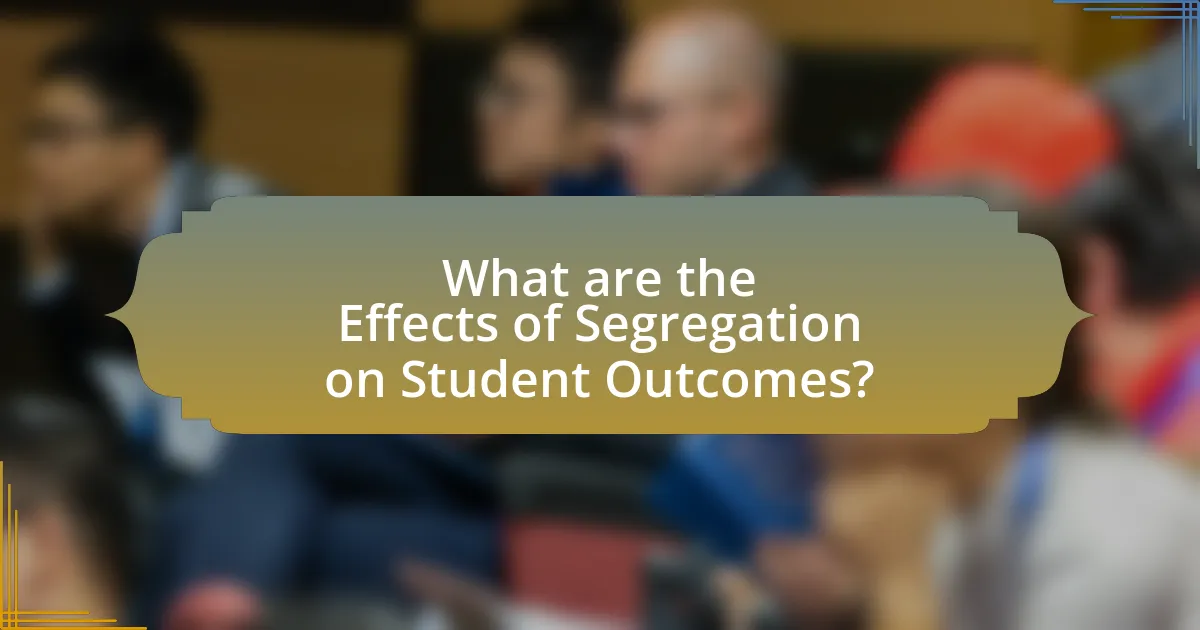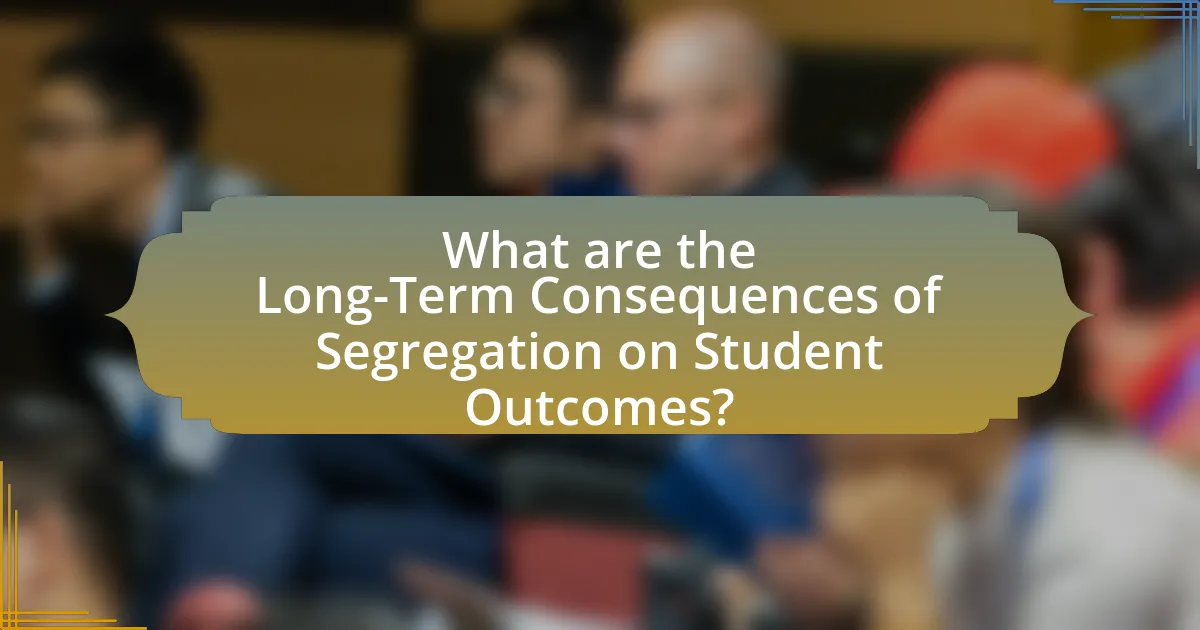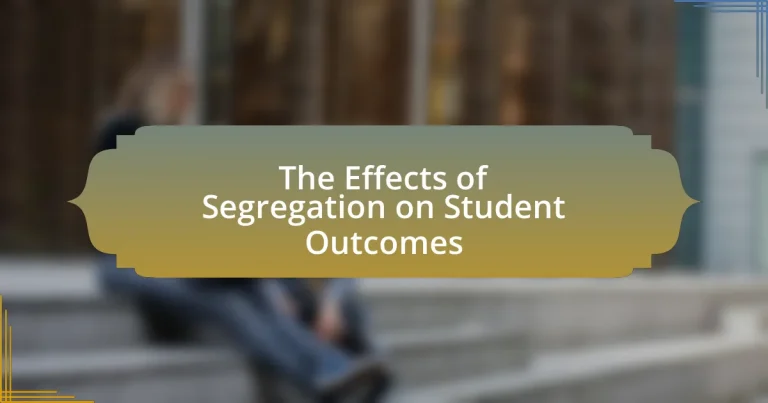The article examines the effects of segregation on student outcomes, highlighting how it exacerbates educational inequalities. It discusses the negative impact of segregation on academic performance, including lower standardized test scores, graduation rates, and college enrollment among marginalized groups. Additionally, the article explores the social effects of segregation, such as increased isolation and reduced opportunities for diverse interactions, which can hinder social skills and mental health. It emphasizes the importance of understanding these effects to inform educational policies aimed at promoting equity and improving student outcomes. The article also outlines strategies for mitigating segregation’s impact, including equitable funding, community engagement, and inclusive educational practices.

What are the Effects of Segregation on Student Outcomes?
Segregation negatively impacts student outcomes by exacerbating educational inequalities. Research indicates that students in segregated schools often have access to fewer resources, lower-quality teachers, and diminished academic opportunities. For instance, a study by the National Bureau of Economic Research found that students in predominantly minority schools score significantly lower on standardized tests compared to their peers in more integrated environments. Additionally, segregation contributes to higher dropout rates and lower college enrollment among marginalized groups, as highlighted in the Civil Rights Project’s report on the state of school segregation in the United States. These factors collectively hinder the academic and social development of students in segregated settings.
How does segregation impact academic performance?
Segregation negatively impacts academic performance by creating disparities in educational resources and opportunities. Research indicates that students in segregated schools often have access to fewer qualified teachers, advanced coursework, and extracurricular activities, which are crucial for academic success. For instance, a study by the National Bureau of Economic Research found that students in predominantly minority schools score significantly lower on standardized tests compared to their peers in more integrated environments. This disparity is further exacerbated by socioeconomic factors, as segregated schools often serve lower-income communities, limiting access to essential educational support and resources.
What specific academic metrics are affected by segregation?
Segregation specifically affects academic metrics such as standardized test scores, graduation rates, and college enrollment rates. Research indicates that students in segregated schools often have lower standardized test scores due to disparities in resources and instructional quality. For instance, a study by the National Center for Education Statistics found that schools with high concentrations of low-income students, often a result of segregation, had significantly lower graduation rates compared to more integrated schools. Additionally, segregation negatively impacts college enrollment rates, as students from segregated backgrounds may have limited access to advanced coursework and college preparatory resources, leading to lower rates of post-secondary education enrollment.
How do disparities in resources influence student outcomes?
Disparities in resources significantly influence student outcomes by creating unequal access to educational opportunities and support systems. Schools with limited funding often lack essential materials, experienced teachers, and extracurricular programs, which directly impacts student engagement and achievement. For instance, research from the National Center for Education Statistics indicates that schools in low-income areas receive about $1,000 less per student compared to those in wealthier districts, leading to lower test scores and graduation rates. This resource gap perpetuates cycles of disadvantage, as students from under-resourced schools are less likely to pursue higher education or secure well-paying jobs, further entrenching socioeconomic disparities.
What social effects does segregation have on students?
Segregation has significant social effects on students, primarily leading to increased social isolation and reduced opportunities for cross-cultural interactions. Students in segregated environments often experience limited exposure to diverse perspectives, which can hinder their social development and understanding of different cultures. Research indicates that such isolation can contribute to lower levels of empathy and social cohesion among students. For instance, a study by the National Education Association found that students in racially and economically segregated schools are less likely to develop friendships with peers from different backgrounds, which negatively impacts their social skills and ability to collaborate in diverse settings.
How does segregation affect peer relationships and social skills?
Segregation negatively impacts peer relationships and social skills by limiting interactions among diverse groups. When students are segregated, they often miss opportunities to develop essential social skills, such as empathy and cooperation, which are fostered through diverse peer interactions. Research indicates that students in segregated environments tend to have narrower social networks and reduced exposure to different perspectives, leading to difficulties in forming relationships outside their immediate group. For instance, a study by the National Center for Education Statistics found that students in racially and economically segregated schools reported lower levels of social engagement and collaboration skills compared to their peers in integrated settings. This lack of interaction can hinder their ability to navigate social situations effectively in broader contexts.
What role does segregation play in student mental health?
Segregation negatively impacts student mental health by creating environments that foster isolation, discrimination, and unequal access to resources. Research indicates that students in segregated schools often experience higher levels of stress and anxiety due to a lack of social support and exposure to diverse perspectives. For instance, a study published in the American Journal of Public Health found that students in racially and economically segregated schools reported lower levels of psychological well-being and higher instances of depressive symptoms. This evidence underscores the detrimental effects of segregation on the mental health of students, highlighting the need for integrated educational environments to promote better mental health outcomes.
Why is understanding the effects of segregation important?
Understanding the effects of segregation is important because it directly impacts educational equity and student outcomes. Research indicates that segregated schools often receive fewer resources, leading to disparities in educational quality. For instance, a study by the National Center for Education Statistics found that schools serving predominantly minority students are more likely to have inexperienced teachers and less access to advanced coursework. This inequity contributes to lower academic achievement and higher dropout rates among students in segregated environments, highlighting the critical need for policies aimed at desegregation to improve educational opportunities for all students.
How can awareness of these effects influence educational policy?
Awareness of the effects of segregation on student outcomes can significantly influence educational policy by prompting reforms aimed at promoting equity and inclusivity in schools. Research indicates that segregated educational environments often lead to disparities in academic achievement, social development, and access to resources, which can be addressed through policy changes. For instance, studies have shown that students in integrated settings perform better academically and have improved social interactions, highlighting the need for policies that encourage diverse school environments. By understanding these effects, policymakers can implement strategies such as redistricting, funding for under-resourced schools, and programs that foster collaboration between diverse student populations, ultimately aiming to close the achievement gap and enhance overall educational equity.
What implications do these effects have for future generations?
The effects of segregation on student outcomes have significant implications for future generations, primarily perpetuating educational inequities. Research indicates that students from segregated schools often receive fewer resources, lower-quality instruction, and diminished access to advanced coursework, which can hinder their academic achievement and future career opportunities. For instance, a study by the National Bureau of Economic Research found that students in highly segregated schools are less likely to graduate from high school and pursue higher education, leading to long-term socioeconomic disadvantages. Consequently, these educational disparities can result in a cycle of poverty and limited social mobility for future generations, reinforcing systemic inequalities within society.

What are the Long-Term Consequences of Segregation on Student Outcomes?
The long-term consequences of segregation on student outcomes include significant disparities in academic achievement, social mobility, and mental health. Research indicates that students in segregated schools often have access to fewer resources, lower-quality teachers, and diminished educational opportunities, which can lead to lower graduation rates and reduced college enrollment. For instance, a study by the National Bureau of Economic Research found that students from predominantly minority schools are less likely to graduate from high school and attend college compared to their peers in integrated settings. Additionally, segregation contributes to social isolation and limited exposure to diverse perspectives, negatively impacting students’ social skills and emotional well-being. These factors collectively hinder long-term success and perpetuate cycles of poverty and inequality.
How does segregation affect college readiness and enrollment?
Segregation negatively impacts college readiness and enrollment by limiting access to quality educational resources and opportunities. Students in segregated schools often face inadequate funding, less experienced teachers, and fewer advanced placement courses, which hinders their academic preparation for college. Research indicates that schools serving predominantly minority populations receive significantly less funding compared to those in affluent areas, leading to disparities in educational outcomes. For instance, a study by the U.S. Department of Education found that schools with high concentrations of low-income students are less likely to offer rigorous coursework, which is crucial for college readiness. Consequently, these factors contribute to lower enrollment rates in higher education institutions among students from segregated backgrounds.
What barriers do segregated students face in accessing higher education?
Segregated students face significant barriers in accessing higher education, primarily due to socioeconomic disadvantages, limited access to quality educational resources, and systemic discrimination. Research indicates that students from segregated backgrounds often attend underfunded schools, which lack advanced placement courses and experienced teachers, leading to lower academic preparedness for college. According to the National Center for Education Statistics, schools serving predominantly minority students receive about $1,000 less per student than those serving predominantly white students. Additionally, these students may encounter financial obstacles, as they are more likely to come from low-income families, limiting their ability to afford college tuition and related expenses. Furthermore, systemic biases in college admissions processes can disadvantage segregated students, as they may not have the same access to college counseling and networking opportunities as their peers in more affluent, integrated schools.
How does early segregation influence career opportunities later in life?
Early segregation significantly limits career opportunities later in life by restricting access to quality education and resources. Research indicates that students from segregated schools often receive inferior educational experiences, which can lead to lower academic achievement and reduced skill development. For instance, a study by the National Bureau of Economic Research found that students in racially segregated schools are less likely to graduate from high school and pursue higher education, which directly correlates with diminished job prospects and earning potential. Furthermore, early segregation fosters social networks that are less diverse, limiting exposure to varied career paths and professional mentorship, ultimately constraining individuals’ career trajectories.
What are the economic impacts of segregation on communities?
Segregation negatively impacts the economic stability and growth of communities by perpetuating inequality and limiting access to resources. Economically segregated communities often experience lower property values, reduced investment, and limited job opportunities, which can lead to a cycle of poverty. For instance, a study by the National Bureau of Economic Research found that neighborhoods with high levels of segregation tend to have lower average incomes and higher unemployment rates. Additionally, segregated areas often lack access to quality education and healthcare, further exacerbating economic disparities. This systemic inequality not only affects individual families but also hinders overall community development and economic progress.
How does educational segregation contribute to economic inequality?
Educational segregation contributes to economic inequality by limiting access to quality education for marginalized groups, which in turn restricts their economic opportunities. When students from low-income or minority backgrounds are segregated into underfunded schools, they often receive fewer resources, less experienced teachers, and lower-quality curricula. For example, a study by the National Center for Education Statistics found that schools serving predominantly low-income students receive about $1,000 less per pupil than those serving wealthier populations. This disparity in educational quality leads to lower graduation rates and diminished job prospects, perpetuating a cycle of poverty and economic disadvantage.
What are the long-term societal costs of segregated education systems?
The long-term societal costs of segregated education systems include increased inequality, reduced economic mobility, and diminished social cohesion. Segregated education often leads to disparities in funding and resources, which perpetuates cycles of poverty and limits opportunities for marginalized groups. Research indicates that students in segregated schools typically receive lower-quality education, resulting in lower academic achievement and higher dropout rates. For instance, a study by the National Center for Education Statistics found that schools serving predominantly minority students often have fewer experienced teachers and less access to advanced coursework. This educational disadvantage translates into long-term economic impacts, as individuals from segregated backgrounds may struggle to secure well-paying jobs, thereby affecting overall economic growth and stability in society. Additionally, segregation fosters social divisions, leading to increased tensions and reduced community engagement, which can hinder collective problem-solving and social progress.
What can be done to mitigate the effects of segregation?
To mitigate the effects of segregation, implementing policies that promote equitable funding for schools is essential. Research indicates that schools in segregated areas often receive less funding, leading to disparities in educational resources and opportunities. For instance, the Education Trust found that schools serving predominantly low-income students receive about $1,000 less per student than those serving wealthier populations. Additionally, fostering diverse school environments through controlled choice programs and magnet schools can enhance student interactions across different backgrounds, which has been shown to improve academic outcomes and social cohesion. Studies, such as those conducted by the National Bureau of Economic Research, demonstrate that students in diverse settings perform better academically and develop stronger social skills.
What strategies have proven effective in reducing segregation in schools?
Effective strategies for reducing segregation in schools include implementing controlled choice programs, increasing funding for diverse schools, and promoting inclusive curricula. Controlled choice programs allow families to select schools while ensuring a balance of demographics, which has been shown to improve integration. Research indicates that increased funding for schools in diverse areas leads to better resources and opportunities for all students, thereby attracting a more varied student body. Additionally, inclusive curricula that reflect diverse histories and cultures foster a sense of belonging among students from different backgrounds, which can reduce segregation. Studies, such as those conducted by the National Center for Education Statistics, demonstrate that these strategies contribute to more equitable educational environments and improved student outcomes.
How can community engagement play a role in addressing segregation?
Community engagement can significantly address segregation by fostering inclusive dialogue and collaboration among diverse groups. When community members actively participate in discussions and initiatives, they can identify shared goals and work together to dismantle barriers that perpetuate segregation. For instance, research from the National Education Association indicates that schools with strong community ties experience improved student outcomes, as these connections promote resource sharing and support systems that benefit all students, regardless of their background. Engaging the community also encourages the development of programs that celebrate diversity and promote understanding, which can reduce prejudices and foster a more integrated environment.

How Can We Address the Effects of Segregation on Student Outcomes?
To address the effects of segregation on student outcomes, implementing equitable funding and resource allocation in schools is essential. Research indicates that schools in segregated areas often receive less funding, leading to disparities in educational quality. For instance, a study by the Education Trust found that schools serving predominantly students of color receive $23 billion less in funding than those serving mostly white students. Additionally, promoting diverse educational environments through policies that encourage integration can enhance academic performance and social skills. Evidence from the National Bureau of Economic Research shows that students in integrated settings perform better academically and have improved long-term outcomes. Therefore, equitable funding and integration policies are critical strategies to mitigate the negative impacts of segregation on student outcomes.
What policies can be implemented to reduce segregation?
Policies that can be implemented to reduce segregation include inclusive zoning laws, equitable school funding, and community integration initiatives. Inclusive zoning laws can promote diverse neighborhoods by requiring a mix of housing types and affordability levels, which helps to break down economic barriers that contribute to segregation. Equitable school funding ensures that schools in low-income areas receive adequate resources, addressing disparities in educational quality and opportunities. Community integration initiatives, such as promoting mixed-income developments and supporting transportation access, can foster interaction among diverse groups, further reducing social and economic segregation. Research indicates that these policies can lead to improved educational outcomes and social cohesion, as seen in studies like the “Impact of Housing Policy on School Segregation” by the Urban Institute, which highlights the correlation between housing policies and educational equity.
How can school funding be adjusted to promote equity?
School funding can be adjusted to promote equity by implementing a weighted funding formula that allocates more resources to schools serving disadvantaged populations. This approach recognizes the varying needs of students based on socioeconomic status, special education requirements, and English language proficiency. For instance, research from the Education Trust indicates that schools with higher concentrations of low-income students often receive less funding per pupil compared to their wealthier counterparts, exacerbating educational disparities. By redistributing funds to prioritize these schools, states can help level the playing field, ensuring that all students have access to quality education and necessary support services.
What role do local governments play in addressing segregation?
Local governments play a crucial role in addressing segregation by implementing policies and programs aimed at promoting integration and equity in communities. They can influence zoning laws, housing policies, and school district boundaries, which directly impact the demographic composition of neighborhoods and schools. For instance, local governments can adopt inclusionary zoning practices that require a percentage of new housing developments to be affordable for low-income families, thereby fostering diverse communities. Additionally, local governments can allocate resources to improve schools in historically marginalized areas, ensuring that all students have access to quality education. Research indicates that integrated schools lead to better educational outcomes for students, highlighting the importance of local government actions in mitigating the effects of segregation on student achievement.
What are best practices for educators in segregated environments?
Best practices for educators in segregated environments include fostering an inclusive classroom culture, utilizing differentiated instruction, and implementing collaborative learning strategies. Fostering an inclusive culture involves creating a safe space where all students feel valued and respected, which can enhance engagement and participation. Differentiated instruction allows educators to tailor lessons to meet diverse learning needs, ensuring that all students can access the curriculum effectively. Collaborative learning strategies, such as group projects and peer tutoring, promote social interaction and help students develop essential teamwork skills. Research indicates that these practices can lead to improved academic outcomes and social skills among students in segregated settings, as highlighted in studies by the National Education Association.
How can teachers support students from diverse backgrounds?
Teachers can support students from diverse backgrounds by implementing culturally responsive teaching practices. Culturally responsive teaching involves recognizing and valuing students’ cultural identities, which enhances their engagement and learning outcomes. Research indicates that when teachers incorporate students’ cultural references into their curriculum, it leads to improved academic performance and increased self-esteem among students from diverse backgrounds. For example, a study by Gay (2010) highlights that culturally relevant pedagogy fosters a sense of belonging and encourages students to participate actively in their education. By adapting teaching methods to reflect the diverse experiences of their students, teachers can create an inclusive learning environment that promotes equity and success for all learners.
What resources are available for schools to combat segregation effects?
Schools can access various resources to combat the effects of segregation, including federal and state funding programs, community partnerships, and educational initiatives. Federal programs like Title I provide financial assistance to schools with high percentages of low-income students, enabling them to improve educational opportunities and reduce disparities. Additionally, organizations such as the National Equity Project offer training and resources focused on equity in education, helping schools implement inclusive practices. Research indicates that integrated schools can lead to improved academic outcomes for marginalized students, highlighting the importance of these resources in addressing segregation’s negative impacts.
What steps can parents take to support their children in segregated schools?
Parents can support their children in segregated schools by actively engaging in their education and advocating for equitable resources. This includes attending school meetings, communicating regularly with teachers, and ensuring that their children have access to extracurricular activities that promote social integration. Research indicates that parental involvement can significantly enhance student achievement, particularly in under-resourced environments. For instance, a study by the National Center for Education Statistics found that students with involved parents are more likely to have better academic performance and higher self-esteem. Additionally, parents can seek out community programs that provide mentorship and tutoring, which can help bridge the gaps created by segregation.
How can parents advocate for equitable education for their children?
Parents can advocate for equitable education for their children by actively engaging with school boards and local education authorities to address disparities in resources and opportunities. This engagement can include attending meetings, voicing concerns about inequities, and collaborating with other parents to form advocacy groups. Research indicates that schools with higher parental involvement tend to have better student outcomes, highlighting the importance of parental advocacy in promoting equity. For instance, a study by the National Education Association found that schools with strong family engagement practices see improved academic performance and reduced dropout rates among students.
What community resources can parents utilize to enhance student outcomes?
Parents can utilize community resources such as tutoring programs, after-school activities, and local libraries to enhance student outcomes. Tutoring programs provide personalized academic support, which has been shown to improve student performance; for instance, a study by the National Bureau of Economic Research found that students receiving tutoring scored significantly higher on standardized tests. After-school activities, including sports and arts programs, foster social skills and engagement, contributing to better academic performance and emotional well-being. Local libraries offer access to educational materials and programs that promote literacy and learning, which are critical for student success. These resources collectively support academic achievement and personal development, addressing the challenges posed by segregation in educational settings.


